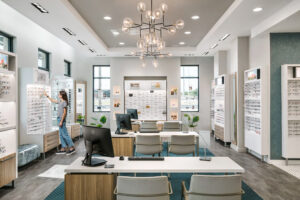
Example of a well-lighted, well-designed optical, belonging to an Eye Designs client. Bobilin notes that the design of your optical is an essential component of increasing eyewear sales.
What not to do–and what to do instead–for a well-designed optical.
By Patricia Bobilin
Nov. 8, 2023
Optical design mistakes can adversely impact patient experience and cut deeply into your sales. Here are a few of the top mistakes and how to do better.
1. Not Budgeting Properly
Establishing a budget that is correct for your practice is key, as the optical is the patient’s first and last impression. In today’s DIY climate it can be a mistake to think that the budget should be based on where you can cut corners.
Make sure your budget includes funds for building a demographically correct design with the right lighting and with commercial grade furniture and also provides for immediate and future growth requirements. Including these things in your optical budget is essential to increase your capture ratio and overall sales.
Additional Tip: Make sure you negotiate enough favorable terms if you’re leasing. For instance, 90 days rent free on a six-month project will leave you exposed to three months with no income from that location.
2. Not Selecting the Right Industry Professionals for the Project
If you’re building a new practice, using general contractors, electricians, plumbers are a given; however, when building out your optical it is critical to the profitability of your optical to use experts who understand the ECP business.
Other Articles to Explore
Using a full-service industry expert that provides complementary interior design, space planning for the optical, retail lighting and branding enhancements, along with the manufacturing of optical furniture, will help you drive more profitability for the optical and enhance the overall project.
3. Not Understanding the Value of Merchandising & How it Affects the Buying Experience
The use of several different merchandising components, such as frame holders, shelving and graphics, offers a more versatile buying experience and determines how you present to your patient base. It is important to utilize your displays as a frame-selling device versus a frame-storage device.
A well-balanced presentation is preferred over merely displaying a large amount of frames. For example, utilize branding components to highlight designer frames, or use frame holders for your lower-end frames, and use shelving for specialty frames to add interest.
Providing the best patient buying experience through your displays is where your capture ratio and second-pair sales will soar.
 Patricia Bobilin is the Managing Director Southern Region for Eye Designs, LLC. To contact her: pbobilin@eyedesigns.com
Patricia Bobilin is the Managing Director Southern Region for Eye Designs, LLC. To contact her: pbobilin@eyedesigns.com

























